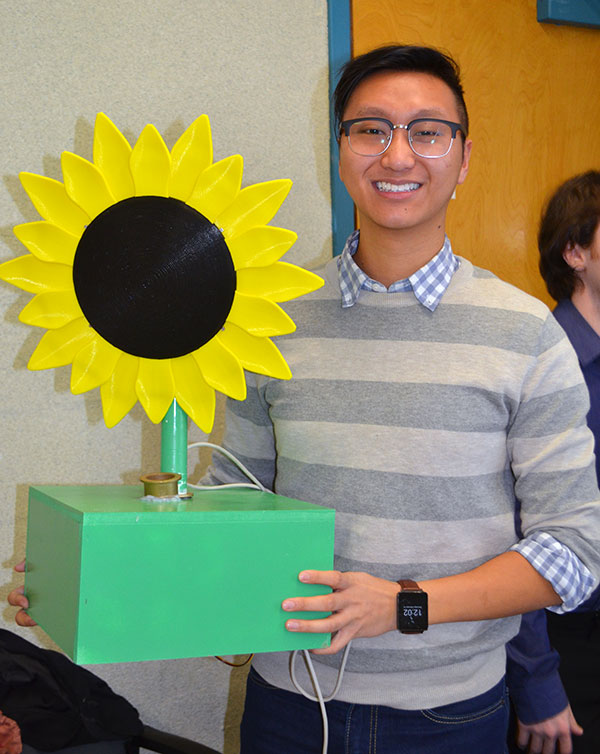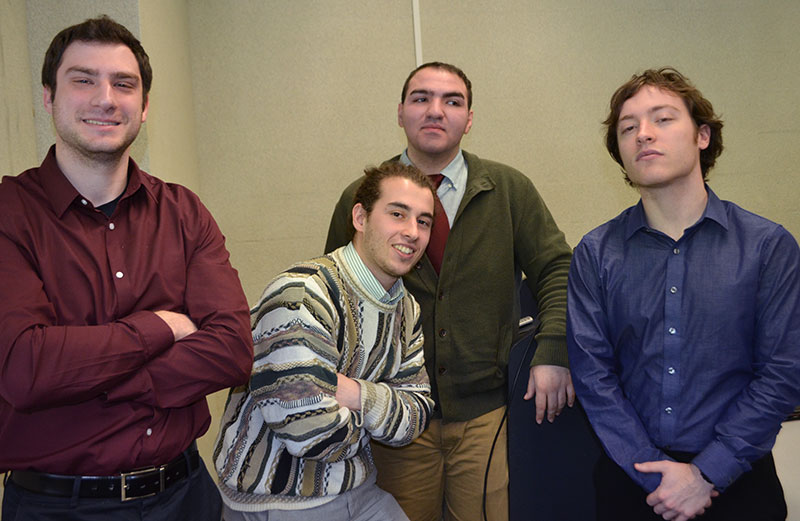If there is an engineering principle in the animal kingdom that can be modeled, MEM 435 students will ferret it out. Want to know how a deer tracks sound? Check. Want to view the world through the eyes of a hammerhead shark? Check. Want to see how a grasshopper breathes, or how a snake rears up to defend itself? Check, check.

“Snake Defense” Team
Five groups of Department of Mechanical Engineering and Mechanics (MEM) students recently presented their prototypes to College of Engineering Dean Sharon L. Walker in a friendly, “bragging rights” competition staged by Dr. Roger Marino, Drexel University associate teaching professor. Charged with developing interactive devices that exhibit an engineering principle found in nature, students designed, built, and performed troubleshooting on their prototypes over 10 weeks during Marino’s Fall 2018 course.
Rather than designate just one of the groups as the winner, Walker took a more companionable approach and chose all five groups. Each student received a participation certificate. “This was really fun,” Walker said after asking questions and exchanging information with the students. “We should do this every year.”

“Grasshopper Respiration” Team

“Hear Like a Deer” Team
In his course, Marino challenges students to develop interactive models that can eventually be utilized as educational tools at either the Adventure Aquarium in Camden or at the Academy of Natural Sciences of Drexel University. According to Mike Kaczmarczik, assistant manager for outreach programs at the Academy, four of the five prototypes presented to Walker will be exhibited at the Academy. Several student groups are continuing into an independent study with their projects.
Among those who participated in the contest and their projects were: “Hear Like A Deer,” with Andrew DiCicco, Kyle Hershman, Micah Watson, and Nicholas Widmann; “Snake Defense,” with Atta Hassan, Ian Mcgowan, and Sebastian Sanchez; “Grasshopper Respiration,” with Mark Macgarvey, Owen Messinger, Jamie Mitchell, and James Wieder; “Hammerhead Shark Vision,” with Noah Alessi, Jonathan El-Khoury, Thomas Flanagan, and Leonardo Fonzetti; and “Phototropism,” with Jonathan Cheng, Omer Dugmeoglu, Stephen Hall, and Matthew Mohnack. All are MEM majors.

“Phototropism”
“This was a great bunch of students to work with. The class is very intensive and we ask a lot of them in one quarter,” said Marino. “It’s amazing that they have such a positive attitude at the end of the quarter. I think part of that reason is that they get invested in the projects and are happy to be doing what engineers do – design, build, and problem-solve.”
Marino added that the students get invaluable assistance from staffers at the Drexel Machine Shop who provide equipment training and materials guidance, along with offering constructive. Input on the design concepts.
MEM Senior Noah Alessi’s group used virtual reality headset technology to show the field of view a hammerhead shark experiences. A hammerhead can see 330 degrees of its surroundings, Alessi said, while human beings take in just 200 degrees.

“Hammerhead Shark Vision” Team
“This concept is fascinating as it involves augmenting the user’s surroundings,” said Alessi. “We saw this as an opportunity to teach a biological principle while also understanding the behind-the-scenes aspects of developing VR technology. It is hard to visualize how animals see the world. By providing an interactive experience, this headset allows the user to leave with a visual companion to an educative principle.”
In his own presentation, “Phototropism,” Jonathan Cheng displayed a large, cheerful sunflower model that turns, twists, and pivots its head in the direction of light sources. “We wanted to spark children’s interest with an eye catching, interactive, robotic sunflower,” said Cheng. “It has four light sensors that allow a 360-degree rotation.”